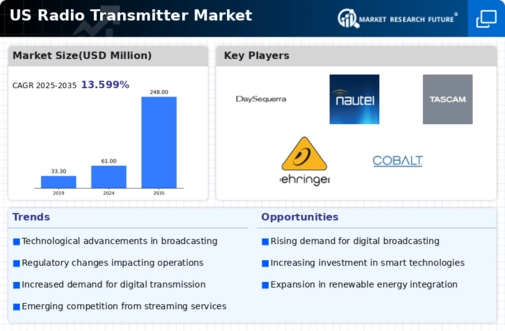The US Radio Transmitter Market is characterized by a competitive landscape driven by technological advancements and the increasing demand for high-quality broadcasting solutions. This market encompasses a range of players who are focused on innovation and enhancing their product offerings to maintain a competitive edge. Companies within this sector strive to meet the diverse needs of broadcasters, incorporating features such as improved signal quality, energy efficiency, and integration capabilities. The market dynamics are influenced by various factors, including regulatory requirements, evolving consumer preferences, and advancements in digital broadcasting technologies.
Companies are not only competing on price but also on the ability to provide reliable support and services, thereby fostering long-term relationships with their clients.DaySequerra stands out as a significant player in the US Radio Transmitter Market, known for its advanced solutions that cater to the evolving needs of radio broadcasters. The company's strengths lie in its expertise in audio processing and monitoring, resulting in products that deliver superior performance with minimal latency. DaySequerra's reputation for reliability and quality is well-regarded among broadcasting professionals, ensuring its products find widespread adoption within the industry.
By consistently focusing on innovation, DaySequerra has secured a notable market presence and continues to push the boundaries of technology in audio processing and transmitter solutions, setting high standards for competitors in the US landscape. Nautel has established itself as a leading entity in the US Radio Transmitter Market, renowned for its extensive portfolio of high-power FM and AM transmitters. The company is recognized for its commitment to quality, efficiency, and sustainability in broadcasting technology, which resonates well with its customer base.
Nautel's key products and services encompass a variety of transmitter models that cater to different broadcasting needs, including advanced digital and analog solutions. The company has expanded its market reach through strategic mergers and acquisitions, enhancing its capabilities and product offerings while strengthening its position in the US market. Nautel is known for providing comprehensive customer support and training, enabling broadcasters to maximize the potential of their transmission systems. This focus on customer success, coupled with a strong emphasis on technology innovation, allows Nautel to maintain a prominent role in the competitive landscape of the US Radio Transmitter Market.














